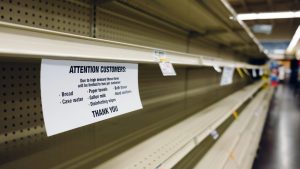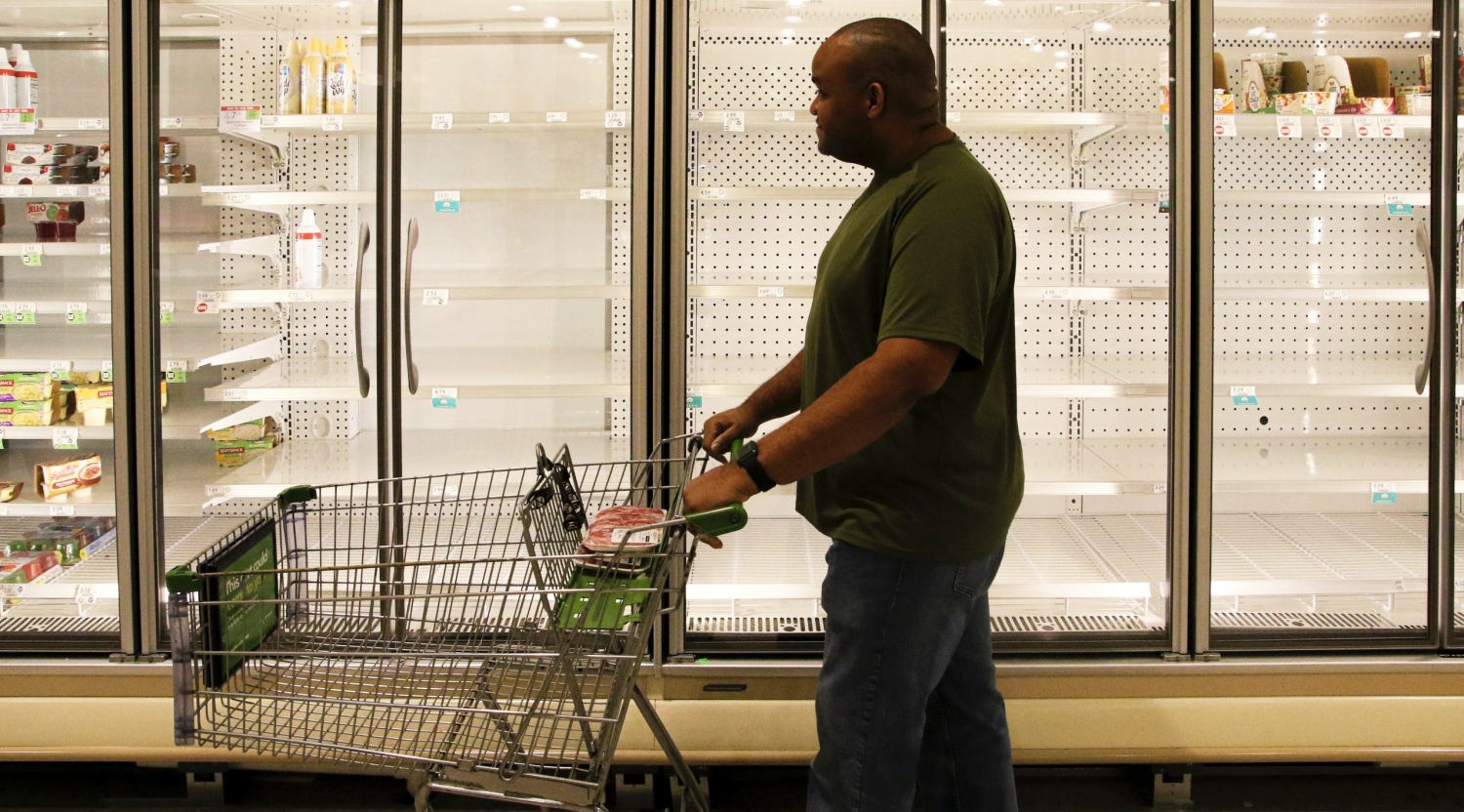COVID-19 has disrupted the way Americans get their food, from shortages on store shelves to shuttered sit-down restaurants to farmers left with surplus products they can’t sell.
To help us understand how our food supply chain works, how the pandemic affects it and how it may change in the future, we turned to two experts with NC State’s Department of Agricultural and Resource Economics. Heidi Schweizer is an assistant professor and extension specialist who studies commodities markets, supply chain management and transportation. Kelly Zering, a professor and extension specialist, has expertise in applied research and extension programs statewide, including economics of pigs and pork production and markets.
Can you give us a simple explanation of what makes up the food supply chain?

Zering: In simple terms, the food supply chain can be characterized as all the steps that have to happen to get food from concept to consumers − and that turns out to be a pretty complicated set of activities. A second way to describe it is that it’s a coordinated series of business interactions to get all those steps completed. Production, transportation, processing, marketing, packaging, distribution, wholesaling, retailing, institutional and restaurant preparation and service are examples of activities that employ millions of people nationally.
Another analogy for the food supply chain would be a pipeline. We think about a pipeline having a certain capacity, a diameter that stuff can move through, and maybe having some bottlenecks or choke points that further limit capacity and throughput. There’s a time and space aspect of a pipeline. When you put something in one end of the pipeline it takes time for it to cover the physical distance to the endpoint.
Schweizer: Agricultural supply chains are interesting to study because they are seasonal. Depending on the product, it may not constantly be moving through the supply chain. At some point in that process it might stop and be held in storage so that we can consume the product year-round. Or it might be that during winter we get certain things from South America and during summer we get certain things from domestic sources.
When it comes to U.S. farming and agriculture, a lot of people are planting right now, or getting ready to plant, and, fortunately, most inputs were already in place by January or February. The issue now is that farmers are going to have to pay for those supplies and commodity prices are low. There are significant credit and cash flow challenges on the production side of things. But I think consumers will eventually be able to get out-of-stock food products. We’ve seen in China people couldn’t get what they needed at the beginning of the crisis but as time went on there were fewer shortages.
If the food supply chain is designed to handle a steady – or at least predictable –
supply of product coming through the pipeline, is that what’s disrupting it right now?

Schweizer: The way modern supply chains are designed, they can usually handle disruptions pretty well. That would be what we call a resilient supply chain. What that means is if there’s shortages in North Carolina, perhaps due to a hurricane, goods can be rerouted from elsewhere to address that. For that to happen, there’s a couple of assumptions we have to make. The first assumption is that there’s good communication between each entity along the pipeline and the second is that other places in the network have relatively level or normal activity.
What’s happening now would be perfectly fine if it was just us here in North Carolina that needed more toilet paper, but the system isn’t designed to handle a sudden worldwide increase in toilet paper demand. And suppliers have to look at their assets and the best use of their capital funds because to be perfectly honest, if we’re talking about paper goods, for example, it’s unlikely to make sense for one of these manufacturing firms to invest in increased capacity if they expect to return to normal levels of production after this is over.
It’s also not easy to make quick shifts in food production. Many agricultural crops are produced once per year. If we’re talking about apples, for example, you have to have an orchard that’s established for years in advance before it starts producing.
How does stockpiling – whether it’s toilet paper or meat or other foods – affect the supply chain?
Zering: The supply chain is pretty well designed to handle local disruptions or even very short-term global disruptions. But we went through a shift a decade or two ago to what was called “just in time” production. Built in to the system now is this efficiency where the system is designed to handle, produce and deliver just as much product as consumers need at any point in time. There’s not a lot of surplus because it’s expensive to store things and have big inventories sitting around. You have this pipeline that’s running pretty close to capacity most of the time and now you create this global demand spike all of a sudden where everybody wants to buy not one or two weeks’ worth, but a month’s worth of products – and the pipeline may only have one week’s worth of product close to consumers at that point.
Consumers overwhelm the system by trying to buy several times as much of a product as would normally be consumed in a period of time. That’s the stockpiling or hoarding impact, and we see it here during hurricanes. People are buying for maybe, worse-case scenario, power’s going to be out for a week or roads are going to be closed for a few days. People buy an extra week of supplies and maybe the bread shelf goes empty. The main problem with this spike in demand is there’s just not enough capacity in the system to deliver it. But with time, the system’s capable of adapting.
We’ve been seeing stories about restaurants selling products directly to consumers, whether it’s meat they normally would have cooked or paper goods they would have used in their restaurants. What effect do these shifts have on the food supply chain?
Zering: We talked about retail demand spiking from people’s stockpiling. In another market channel, demand has collapsed. The demand for sit-down restaurant meals has collapsed because of social distancing. Now restaurants have a surplus of their raw materials. Their pipeline is delivering supplies, and they have no customers to buy them. To maintain some income and sustain their business, they’re changing the way they sell their product. That’s one adjustment that can offset some of the shortages caused by stockpiling. It alleviates some of the disequilibrium that we have.
Schweizer: Restaurants, in particular, are adapting to make things work in the current situation. Those particular supply chains aren’t really optimized for consuming food at home.
What’s affecting the supply of meat available from grocers?
Zering: In the past few weeks, another effect of the disease emerged. The disease is causing disruptive shocks or volatility in some supply chains. Worker illness is causing temporary shutdown of large processing plants and reduced capacity in others. We see farm level prices dropping and cases of farmers having no place to deliver market ready animals or milk. At the same time, processors are warning of potential shortages of retail products and rising retail prices if processing capacity is not restored quickly. These are effects of new bottlenecks disrupting the supply chain. The disruption created the loss of demand for some upstream of the bottleneck and created shortages for others downstream.
Schweizer: Given the resources available in the short term, one of the only ways to increase throughput is to do less processing. Meat packaging is labor intensive, and with some facilities closed and less employees at each facility processors may have to do fewer value-added activities in order to get meat to consumers quicker. Whether or not it is possible to make these kinds of temporary changes to the set of products being offered depends. It would not be problematic to have more whole chickens or turkeys sold in grocery stores, but pasteurization of milk can’t be foregone because that is a safety issue. The livestock industry is in a difficult situation short-term because of these supply chain bottlenecks, but there are also long-term concerns. If there’s a global recession, then the world demand for animal protein may decrease.
If consumers are concerned about where their food is coming from now, could that build interest in products from local farms?
Schweizer: That’s a good question. Food traceability is important because of food safety, but it’s actually become a marketing tool as well. It’s not just for the direct-to-consumer folks. If you went to Harris Teeter last Thanksgiving and bought a Butterball turkey, you could scan it and see the farmer that produced that turkey. I agree it’s a trend that people are starting to show greater interest in where their food comes from, but I don’t know if that necessarily means more direct-to-consumer sales or not.
Zering: We have seen interesting adaptations to pandemic disruption. For example, there’s the MeatSuite.com online marketplace launched by NC Choices, a program from two NC State-affiliated programs, the Center for Environmental Farming Systems and N.C. Cooperative Extension. It enables local farmers and meat consumers to find each other and sell products. Another example: a large North Carolina chicken processor has been delivering tractor trailer loads of 40-pound boxes of chicken direct to consumers, rerouting product that might have gone to institutions or chain restaurants.
It remains to be seen how recent changes persist after the immediate shocks pass. People will continue to demand and desire products that are produced elsewhere because they’re not available here or they’re available at a lower cost from somewhere else.
I don’t think long supply chains are going away. Before the pandemic we saw tariff shocks internationally and we’ve had weather-driven shocks such as droughts in some parts of the world that disrupt supply. I think companies in the supply chain will be looking at ways to add more resilience to their supply of resources and the way they provide products to customers.
Can you offer any kind of reassurance to people who may not remember seeing store shelves bare of products for this long?
 Zering: One thing I would say to reassure people is that the reason the shelves were empty is because of stockpiling rather than lack of availability. Retailers have adopted policies such as limiting how much each consumer can take per visit to reduce the impacts of stockpiling. The demand shock is like a wave. There’s a period of very high water, and when the wave passes the water’s actually lower than the normal level. One problem for the supply chain now is once everybody’s completed their stockpiles and the pandemic passes to some degree, people start living off their stockpile and they buy less than they normally would. There’s going to be that low demand part of the wave at some point. I think supply chains are adapting. They are restocking shelves and will keep restocking them and eventually we can get back to more normal consumption patterns.
Zering: One thing I would say to reassure people is that the reason the shelves were empty is because of stockpiling rather than lack of availability. Retailers have adopted policies such as limiting how much each consumer can take per visit to reduce the impacts of stockpiling. The demand shock is like a wave. There’s a period of very high water, and when the wave passes the water’s actually lower than the normal level. One problem for the supply chain now is once everybody’s completed their stockpiles and the pandemic passes to some degree, people start living off their stockpile and they buy less than they normally would. There’s going to be that low demand part of the wave at some point. I think supply chains are adapting. They are restocking shelves and will keep restocking them and eventually we can get back to more normal consumption patterns.
Schweizer: There will continue to be food available but perhaps not the selection we’re used to. A larger concern in my mind is how economic hardship will affect consumers’ ability to purchase food. Job loss and income reduction will certainly increase food insecurity.
What kinds of long-term changes could we see in buying habits?
Zering: We were already in a transition away from traditional retail distribution toward more online shopping and home delivery of goods and services. A computer scientist that I work with used the term “hard reset.” Maybe this will be a hard reset for the way we do some things. It might be a sudden shift to more online shopping and home delivery because more people are trying it now or relying on it more now than they did in the past. They may realize, “Hey, this is fairly easy and cost effective, and I’m going to do more of it going forward,” and so maybe we have that kind of lasting change from this shock to the system.
The amount of travel and in-person meeting that we do may be permanently changed. Again, it was already happening, but this may be a big blip on the screen, a shift toward more online meeting and a shift away from commuting and costly travel to meetings.
Schweizer: On the supply chain side, I think different companies are going to handle it in different ways. For example, Amazon – the reason they’re able to do one-day shipping is because they have predictive analytics that anticipate what will be bought within a community and place that item there before you purchase it. You can get orders in one day because it’s already in Raleigh, but they are struggling to do that now with the changes in demand. I imagine they’re looking seriously at their supply chain data. Probably Walmart and Target are, too. One thing they might do is put in stricter requirements for their suppliers to share information with them, which they were already starting to do but now they have more urgency. Larger companies are getting real-time data via QR codes or RFID chips or whatever. It’s collected passively. It’s really a lot of data, but retailers have big data experts that work with that. Smaller companies don’t have the same resources.
Is there anything different from an agricultural economics perspective that you’re seeing with the pandemic?
Schweizer: Well, prices of agricultural commodities and the stock market usually move in opposite directions. So even though there are low commodity prices, there’s a large demand for food, for protein, for things like that. But what we’re seeing right now is new in the sense that both commodity prices are low and other industries are also struggling. Long term, maybe even short term, I’m not sure what that means, but that’s something that I would say makes the circumstances unusual.
Zering: I agree with that. With very few events – I don’t know if there’s ever been one actually that I can remember, and I’ve been at this job for 36 years – but I don’t remember an event that had such a tremendous effect on the U.S. economy or the global economy. You think of the number of people who are becoming unemployed right now – and we hope that’s a fairly short-term situation – but what it means is they don’t have as much money as they normally would have to buy goods and services. Demand for all kinds of products is being reduced, and we’re talking about businesses closing as well because there’s no demand for their goods and services for an extended period.
Restaurants typically operate on a pretty thin margin and there’s a pretty high frequency of bankruptcy, but this could be one of the largest periods of bankruptcies in those kinds of businesses that we’ve ever seen. There’s a very unusual shock to the economy happening here and you see effects. I don’t remember a $2.2 trillion relief bill being passed before. That sounds like the annual budget. That doesn’t sound like a temporary relief bill. So that’s evidence of how big this is. One reason the government is doing this is to keep the economy functioning at some level and soften the blow of this huge shutdown in activity. It’s going to take some time for us to figure out which companies are able to bounce back and even which industries are able to bounce back and how quickly. Some companies may really prosper. There are sudden surges in demand for services from Zoom and Amazon and others. At the same time, other companies are being severely injured by lost revenue and may disappear. You can think of it as an evolutionary event due to this tremendous disruption.
I think this really does underline the need for substantial investment globally, nationally and locally in infectious disease monitoring and management. Compared to the trillions of dollars being lost in the economy, I could see a substantial investment being made to really boost that part of the economy. Recently, I’ve been working with NC State professor Jean Ristaino, who studies the history and biology of plant diseases and epidemics like the Irish potato famine. She studies the disease across many scales, from genetics to epidemiology. She works on minimizing the effects of plant diseases, from improved detection to prevention, treatment, strategy and policy. Her team’s recent work on new nanoscale plant monitors has been widely reported. There is a remarkable amount of work done and more being done on monitoring and control of animal infectious diseases. In some ways the preparation for and management of human infectious disease seems to be lagging behind what we’ve seen in agriculture. Many of the principles and some research in agriculture have applications in human health as well.
There’s huge potential for application of emerging technology for early detection and response to new outbreaks of diseases. The extraordinary need for ability to develop tests quickly and disseminate them through the healthcare system, and the need for capacity to rapidly develop and deploy vaccines and treatments to manage effects of disease have been dramatically highlighted in recent weeks. The need for improved prior assessment and implementation of strategy and policy is also evident, in supply chains, in healthcare systems and in societal governance. A hope and a determination as we emerge from this tragedy is that we may soon become far more capable of minimizing loss from future outbreaks of human diseases, as well as animal and plant diseases.
This post was originally published in College of Agriculture and Life Sciences News.
- Categories:



